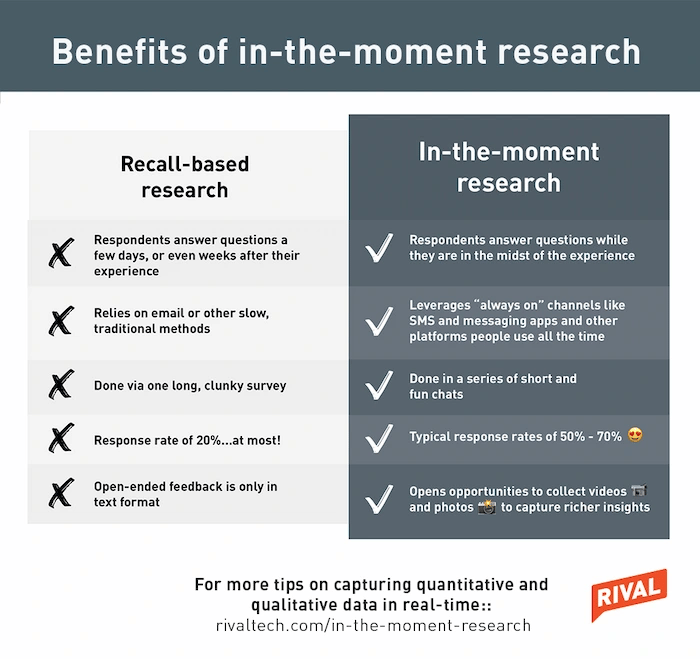
In-the-moment research is useful for one very simple reason: human memory is not very reliable.
Market research is most powerful when it reveals the authentic thoughts and feelings of consumers. If you can get people’s unfiltered feedback, you’re more likely to uncover insights that will improve your relationship with your customers and ultimately drive positive business outcomes.
In-the-moment research is an effective way of capturing people’s authentic opinions, attitudes and preferences. It’s an approach that puts you right in the moment of the experience — and delivers more accurate insights in the process.
With the ubiquity of smartphones and the rise of mobile research, it has never been easier to capture both qualitative and quantitative feedback in real-time. In this article, I’ll provide a quick overview of the benefits and most common uses of in-the-moment research.
One common criticism of survey research is that it relies heavily on recall. Because people have to remember their experiences, they are more likely to rationalize their responses or misremember details, and less likely to share authentic and honest feedback. Concern for this “recall bias” is not new in market research — it has been part of the discourse in our practice for decades.
Recent neuroscience advancements aim to uncover the automatic, fast and unconscious thoughts of respondents (which many in our industry refer to as “System 1 decision making”). The goal is to reduce the need to ask consumers what they did, thought or felt, and in the process, capture their true motivations, feelings or perceptions.
While these developments can certainly uncover interesting insights, they don’t sufficiently replace having real conversations with customers. For many business questions, inferring can only take you so far. At some point, you have to ask customers directly to get a clear and accurate understanding of their attitudes and opinions.
To maximize the business value of surveys, researchers need to minimize recall bias as much as possible.
By letting companies talk to a significant number of people and in a structured format, surveys are still an effective way of listening to customers. For in-the-moment research, in particular, mobile surveys are useful. But to maximize the business value of surveys, researchers need to minimize recall bias as much as possible. The key is to re-imagine this classic market research tool and leverage new technologies and fresh thinking to reduce the need for recall.
In-the-moment research is useful for one very simple reason: human memory is not very reliable. Most people aren’t very good at remembering what they did yesterday... or even an hour ago. The closer you can get to the moment of the experience, the more accurate and detailed your insights will be.

When you look back at an event, you can broadly remember whether you loved it or hated it. But what drives satisfaction are the details. These smaller elements of the experience are harder to capture in a post-event survey because people simply don’t remember what happened.
In-the-moment research addresses the big challenges posed by recall-based approaches.
Our experience working with clients from a wide variety of industries shows that in-the-moment research improves people’s feelings toward the company. Since they are being asked for their feedback in real-time, participants feel like special insiders and ambassadors who get to share their input directly with the brand. They’re still very willing to provide constructive feedback, but they also appreciate the opportunity to influence the company’s decision-making.
Engaging people in-the-moment can be an effective way of improving the respondent experience and boosting participation rates. People are more likely to respond if they are answering questions about an experience that is currently happening or that happened recently. Real-time participation eases the effort of racking your brain because the details are still fresh in your mind—it’s a more natural and easier way of providing feedback.
Another big benefit of in-the-moment research is speed. This type of research yields faster results, allowing research teams to be more agile and capture insights quicker.
Imagine being able to present audience feedback about a new TV show at the same time as the Nielsen ratings. With in-the-moment research, this is easy to accomplish, and, in fact, it's something we're doing with a major cable network client.
In sum, by eliminating the lag time between the activity you wish to explore and the sharing of feedback, in-the-moment research addresses the big challenges posed by recall-based approaches.
One misconception about in-the-moment research is that it’s only for live events and conferences. In reality, this type of research is more than just about event surveys. It has broad applications and is useful for a variety of market research projects.
Broadly speaking, there are three major categories of uses cases for in-the-moment research:
Many long-standing practices that work for recall-based methods aren’t necessarily useful for in-the-moment research. For instance, long surveys are a big no-no. Since people are answering in real time about an experience they are having in the moment, they are on the go and won’t be receptive to a 20-minute survey.
Perhaps more importantly, everything about the research experience needs to be mobile-first. It’s not enough to be mobile-friendly: everything about your survey—from the UX to the language and tone you use—need to be optimized for mobile devices. At Rival, our solution is what we’re calling chats—conversational surveys that are optimized for mobile messaging services. A research-on-research we released last year found that compared to traditional online surveys, chats provide a better respondent experience without introducing any demographic skews.
Interested in learning more about best practices for in-the-moment research? Check out our ebook Stop Relying on Recall: How to Get In-the-Moment Feedback by Engaging Research Participants in Real Time.
Subscribe to our blog to receive the latest news, trends and best practices from market research experts.


No Comments Yet
Let us know what you think